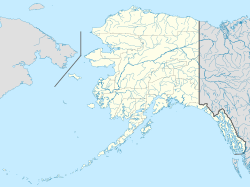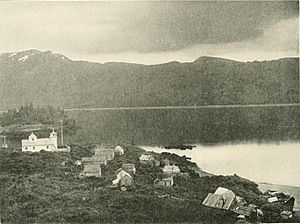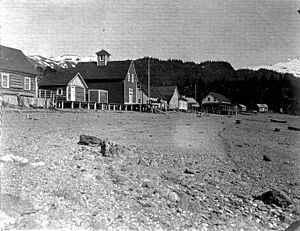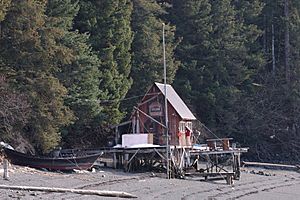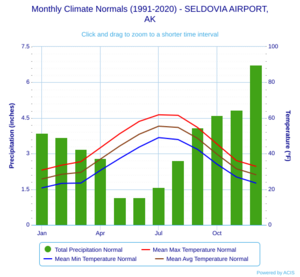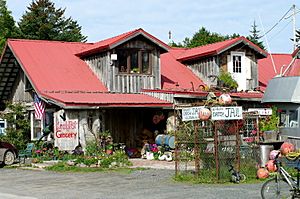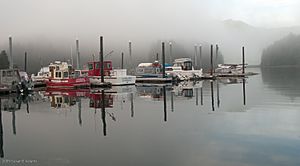Seldovia, Alaska facts for kids
Quick facts for kids
Seldovia
Angagkitaqnuuq
|
|
|---|---|
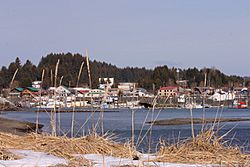
Seldovia, Alaska
|
|
| Motto(s):
"Alaska's Best Kept Secret"
|
|
| Country | United States |
| State | Alaska |
| Borough | Kenai Peninsula |
| Incorporated | May 7, 1945 |
| Area | |
| • Total | 0.55 sq mi (1.42 km2) |
| • Land | 0.39 sq mi (1.00 km2) |
| • Water | 0.16 sq mi (0.42 km2) |
| Elevation | 52 ft (16 m) |
| Population
(2020)
|
|
| • Total | 235 |
| • Density | 607.24/sq mi (234.54/km2) |
| Time zone | UTC-9 (Alaska (AKST)) |
| • Summer (DST) | UTC-8 (AKDT) |
| ZIP code |
99663
|
| Area code | 907 |
| FIPS code | 02-68340 |
| GNIS feature ID | 1413937 |
Seldovia is a small city in Alaska, located on the Kenai Peninsula. Its name comes from different native languages, like Alutiiq (Angagkitaqnuuq) and Dena'ina (Angidahtnu'). In 2020, about 235 people lived there.
Seldovia is found along Kachemak Bay, southwest of Homer. You can only reach Seldovia by airplane or boat, as there are no roads connecting it to other towns.
Many of the people in Seldovia are Alaska Natives. Their ancestors include Aleut and Alutiiq (Sugpiaq) people, and some Dena'ina.
Contents
A Look at Seldovia's Past
The first people to live in this area were a mix of Dena'ina Athabaskan Indians and Alutiiq (Sugpiaq) Eskimos. Around 1787 or 1788, a Russian fur trade post was set up here. It was called Aleksandrovskaia.
People believe that the early Russian St. Nicholas Orthodox Church, built in 1820, was placed on an older Inuit village site. The original Russian name for the town, Seldevoy, means "Herring Bay." This is because there used to be a lot of herring fish here. However, overfishing in the early 1900s greatly reduced their numbers.
Before Alaska had many roads, Seldovia was an important stop for ships. These ships sailed from places like Seward and Kodiak into Cook Inlet. At one time, over 2,000 people lived in Seldovia. Today, fewer than 300 people live there all year.
Seldovia is known for having some of the biggest tide changes in North America. Before 1964, the water in Cook Inlet would rise or fall about 26 feet every six hours during peak tides. This is similar to the huge tides in the Bay of Fundy.
How the 1964 Earthquake Changed Seldovia
On March 27, 1964, a very powerful earthquake, known as the Good Friday earthquake, hit Alaska. It was a 9.2 magnitude earthquake. This earthquake caused the land around Seldovia to drop by six feet.
Before the earthquake, Seldovia had a famous "boardwalk." This was a thick wooden path built on pilings along the waterfront. Most of the town's businesses and homes were also built on pilings over the water. When the land dropped, the tides became even higher, reaching 32 feet. This caused the boardwalk to go completely underwater and flooded many homes and businesses.
After the earthquake, the waterfront was rebuilt. Workers used dirt from a hill called Cap's Hill to raise the ground. This helped to rebuild the town on higher land. Today, only a small part of the boardwalk remains. It was built after the original one and is called "the new boardwalk." The original boardwalk was destroyed during the rebuilding process.
Seldovia has had many different jobs and businesses over the years. These include fox farming, picking berries, and commercial fishing, especially for King Crab. Logging and mining were also important. Today, many people visit Seldovia for sport fishing. Charter boats take them to the best fishing spots in Kachemak Bay.
Who Lives in Seldovia?
| Historical population | |||
|---|---|---|---|
| Census | Pop. | %± | |
| 1880 | 74 | — | |
| 1890 | 99 | 33.8% | |
| 1900 | 149 | 50.5% | |
| 1910 | 173 | 16.1% | |
| 1920 | 258 | 49.1% | |
| 1930 | 379 | 46.9% | |
| 1940 | 410 | 8.2% | |
| 1950 | 437 | 6.6% | |
| 1960 | 460 | 5.3% | |
| 1970 | 437 | −5.0% | |
| 1980 | 479 | 9.6% | |
| 1990 | 316 | −34.0% | |
| 2000 | 286 | −9.5% | |
| 2010 | 255 | −10.8% | |
| 2020 | 235 | −7.8% | |
| U.S. Decennial Census | |||
Seldovia first appeared in the U.S. Census in 1880. At that time, it was made up of two small villages. In 1945, Seldovia officially became a city.
In 2010, there were 255 people living in Seldovia. About 72.5% of the people were White, and 13.7% were Native American. About 11.4% of the people were from two or more races.
The average age of people in Seldovia in 2010 was about 48 years old. About 20% of the population was under 18 years old.
Where is Seldovia Located?
Seldovia is on the Kenai Peninsula in Alaska. It is on the south side of Kachemak Bay, across from Homer. The city is part of the Seldovia Recording District.
The land in Seldovia has been sinking slowly over the last 50 years. The sea level has changed by about 1.6 feet.
The city of Seldovia covers about 0.6 square miles. Most of this area, about 0.4 square miles, is land. The rest, about 0.2 square miles, is water.
What is Seldovia's Climate Like?
Seldovia has snowy winters. Its summers are short and dry. This type of weather is called a Dsc climate by the Koppen climate system.
| Climate data for Seldovia (1991–2020 normals, extremes 1997–present) | |||||||||||||
|---|---|---|---|---|---|---|---|---|---|---|---|---|---|
| Month | Jan | Feb | Mar | Apr | May | Jun | Jul | Aug | Sep | Oct | Nov | Dec | Year |
| Record high °F (°C) | 59 (15) |
51 (11) |
62 (17) |
66 (19) |
71 (22) |
77 (25) |
85 (29) |
80 (27) |
66 (19) |
69 (21) |
59 (15) |
59 (15) |
85 (29) |
| Mean maximum °F (°C) | 43.8 (6.6) |
43.0 (6.1) |
44.5 (6.9) |
52.5 (11.4) |
62.7 (17.1) |
68.8 (20.4) |
72.5 (22.5) |
70.2 (21.2) |
61.8 (16.6) |
55.8 (13.2) |
47.2 (8.4) |
45.8 (7.7) |
73.6 (23.1) |
| Mean daily maximum °F (°C) | 30.8 (−0.7) |
33.5 (0.8) |
35.5 (1.9) |
43.3 (6.3) |
51.2 (10.7) |
58.1 (14.5) |
61.8 (16.6) |
61.5 (16.4) |
54.7 (12.6) |
45.4 (7.4) |
36.1 (2.3) |
32.9 (0.5) |
45.4 (7.4) |
| Daily mean °F (°C) | 25.8 (−3.4) |
28.4 (−2.0) |
29.5 (−1.4) |
36.9 (2.7) |
44.3 (6.8) |
50.9 (10.5) |
55.4 (13.0) |
54.7 (12.6) |
48.6 (9.2) |
39.7 (4.3) |
31.5 (−0.3) |
28.2 (−2.1) |
39.5 (4.2) |
| Mean daily minimum °F (°C) | 20.8 (−6.2) |
23.3 (−4.8) |
23.5 (−4.7) |
30.6 (−0.8) |
37.3 (2.9) |
43.7 (6.5) |
49.0 (9.4) |
47.9 (8.8) |
42.4 (5.8) |
34.1 (1.2) |
26.9 (−2.8) |
23.5 (−4.7) |
33.6 (0.9) |
| Mean minimum °F (°C) | 4.7 (−15.2) |
9.0 (−12.8) |
9.7 (−12.4) |
20.0 (−6.7) |
29.9 (−1.2) |
36.0 (2.2) |
42.0 (5.6) |
39.9 (4.4) |
31.8 (−0.1) |
23.8 (−4.6) |
13.8 (−10.1) |
8.6 (−13.0) |
1.7 (−16.8) |
| Record low °F (°C) | −7 (−22) |
−4 (−20) |
0 (−18) |
6 (−14) |
24 (−4) |
29 (−2) |
37 (3) |
33 (1) |
27 (−3) |
16 (−9) |
1 (−17) |
1 (−17) |
−7 (−22) |
| Average precipitation inches (mm) | 3.87 (98) |
3.68 (93) |
3.19 (81) |
2.80 (71) |
1.15 (29) |
1.15 (29) |
1.58 (40) |
2.71 (69) |
4.09 (104) |
4.60 (117) |
4.83 (123) |
6.74 (171) |
40.39 (1,026) |
| Average precipitation days (≥ 0.01 inch) | 15.1 | 14.6 | 13.3 | 13.2 | 11.7 | 10.9 | 13.1 | 15.4 | 18.3 | 18.1 | 16.8 | 18.0 | 178.5 |
| Source: NOAA | |||||||||||||
What Jobs are in Seldovia?
The main employers in Seldovia are the local school, the Seldovia Village Tribe, the City government, and businesses related to commercial fishing.
Learning in Seldovia
The Susan B. English Grade K-12 School opened on August 30, 1972. The girls' volleyball team won the State Championship in 2002. The boys' basketball team also won the state championship in 2015.
Famous People from Seldovia
- Nell Scott (born around 1901) was the first woman to be elected to Alaska's government.
- Dana Stabenow (born 1952) is a well-known writer.
Seldovia in Books
Seldovia has inspired some children's books!
- In the adventure book Pugs of the Frozen North by Philip Reeve and Sarah McIntyre, the town of Snowdovia is based on Seldovia.
- The Seldovia Sam chapter book series for elementary students is also set in Seldovia. These books, written by Susan Woodward Springer, include titles like Seldovia Sam and the Very Large Clam and Seldovia Sam and the Wildfire Escape.
Images for kids
See also
 In Spanish: Seldovia (Alaska) para niños
In Spanish: Seldovia (Alaska) para niños


